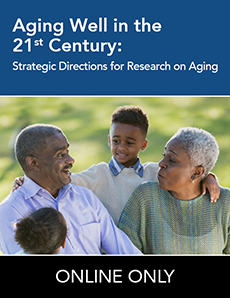Aging Well in the 21st Century: Strategic Directions for Research on Aging
There is no question that Americans have long benefited from sweeping advances in nutrition, sanitation, and medicine that transformed public health practice and dramatically increased average lifespan during the first half of the twentieth century. But it is also true that these advances, along with a mid-century surge in the American birthrate, have brought with them a new set of challenges.
As growing numbers of people live well into their 80s and 90s, age-related diseases and conditions—and the disability often associated with them—continue to be a major public health concern. For example, Alzheimer's disease, cardiovascular disease, cancer, and diabetes remain widespread among older Americans. In addition, many older Americans suffer from multiple chronic health conditions, complicating treatment and impairing quality of life.
At the same time, we are only beginning to understand and address the social, economic, and health service implications of the United States' changing demographics. Our health care, insurance, and retirement systems face

the daunting task of meeting the needs of a rising number of "customers", and the impact of an increasingly elderly population on our communities is not fully understood.
To reduce the burden of illness, enhance quality of life, and maintain health among older adults, we must first understand the aging contexts for illness and health. Some biological, physical, emotional, and cognitive changes are normal with increasing age, and so we seek deeper knowledge of what happens to our bodies and minds over time, influenced by genetics, the environment, and disease-specific processes, and to apply what we have learned to improved health, better function, and reduced risk of disease. To that end, we are exploring "aging" not as a single process, but rather as an intricate web of interdependent genetic, biochemical, physiological, economic, social, and psychological factors.
Modern medicine, healthier lifestyles, and other environmental influences have already allowed a growing number of people to remain healthy and socially and emotionally vital into advanced age. The challenge for the 21st century will be to make these added years as healthy and productive as possible for growing numbers of people.
About This Document
This document outlines the broad strategic directions of the Institute. It provides a point of reference for setting priorities and a framework for systematically analyzing the Institute's scientific portfolio and assessing progress. NIA developed and refined these goals over a period of approximately one year, in close consultation with stakeholders in the research community, non-governmental organizations, partners within the NIH and elsewhere within the federal government, and members of the general public. We will update it as needed as the field of aging research evolves.
Goals
Understanding the Dynamics of the Aging Process
- Goal A: Better understand the biology of aging and its impact on the prevention, progression, and prognosis of disease and disability.
- Goal B: Better understand the effects of personal, interpersonal, and societal factors on aging, including the mechanisms through which these factors exert their effects.
Improving the Health, Well-Being, and Independence of Adults as They Age
- Goal C: Develop effective interventions to maintain health, well-being, and function and prevent or reduce the burden of age-related diseases, disorders, and disabilities.
- Goal D: Improve our understanding of the aging brain, Alzheimer's disease, and other neurodegenerative diseases. Develop interventions to address Alzheimer's and other age-related neurological conditions.
- Goal E: Improve our understanding of the consequences of an aging society to inform intervention development and policy decisions.
- Goal F: Understand health differences and develop strategies to improve the health status of older adults in diverse populations.
Supporting the Research Enterprise
- Goal G: Support the infrastructure and resources needed to promote high quality research.
- Goal H: Disseminate information to the public, medical and scientific communities, and policy makers about research and interventions.
Our vision is to enable all Americans to enjoy robust health and independence with advancing age.

